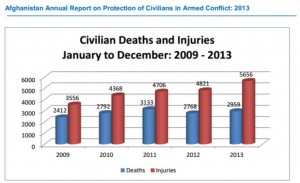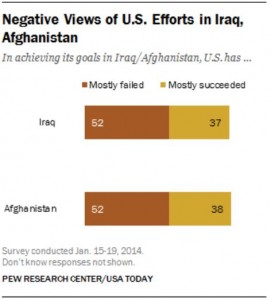Meanwhile, Back in Syria…
The last time I checked in on Syria, there was much consternation over the delays in getting Syria’s chemical weapons precursors sent to the staging area in Latakia so that they can be moved on to the next steps in the process that will eventually result in destruction of the chemicals at sea aboard the Cape Ray. I had noted that stories covering the delay had put all of the blame on Syria for not moving the chemicals (even though they were said already to be at “marshaling” spots) while ignoring that the US was over a month late in making the Cape Ray ready. There has now been a third batch of chemicals sent to Latakia by Syria, but the amount shipped represents a small fraction of the materials to be removed. Despite this, Syria still maintains that the the June deadline for full destruction of the materials will be met.
Going further back, recall that back in September, we were hearing about how wonderful General Salim Idriss is. We were told that he was a moderate (well, that is if we ignore the fellow from his forces who eat hearts of dead foes) and that he had a foolproof plan for maintaining control of arms we shipped to him. It turns out that Idriss wasn’t much of a leader after all. Idriss now has been removed:
The sudden replacement of the Free Syrian Army commander is the strongest sign yet that the rebel group is restructuring to address concerns of its Western backers that it fight both the regime and extremist opposition factions.
Gen. Salim Idriss, the public face of the FSA for the past 14 months, leaves ahead of an expected delivery of new and more sophisticated weapons from Gulf Arab states to rebels aligned with his group.
Complaints against Gen. Idriss have been mounting for some time. His critics said his forces were ineffective and he was too slow to deliver weapons to fighters.
It’s all about the weapons when it comes to “aid” for the Syrian rebels. And Idriss’ control of those weapons? How about this in The Guardian’s coverage of Idriss’ sacking:
The Islamic Front recently seized weapons warehouses from the FSA.
Gosh, I sure hope Idriss got the Islmaic Front to give him a handwritten receipt for those weapons.
But did you notice that bit in the quote above from the Wall Street Journal article, where we learn that Idriss’ removal comes “ahead of an expected delivery of new and more sophisticated weapons from Gulf Arab states”? Iran explains to us in a Fars News article that this really means the weapons will come from Saudi Arabia: Read more →


